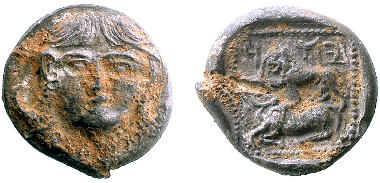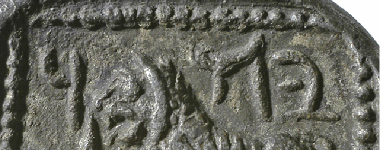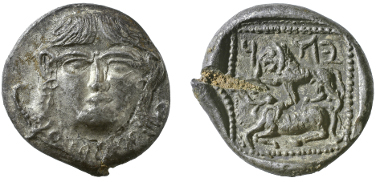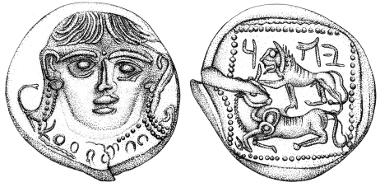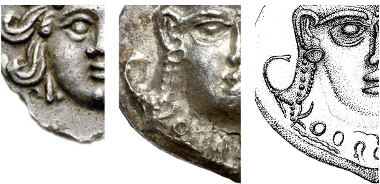by Björn Schöpe
February 20, 2014 – In antiquity the Palestinian region was a melting pot. Various empires shared borders and even local art appeared to be more creative and experimental than in many other places around the Mediterranean as can be clearly seen on its coins.
During the last years Jonathan and Jeannette Rosen collected hundreds of coins minted in ancient Philistia, Samaria and Judah when these parts of Palestine were satrapies (provinces) of the Persian empire. The generous couple donated 1,200 coins to the Israel Museum in Jerusalem. This treasure made the Israel Museum rank for the first time among the short list of the Apollo Magazine’s Acquisition of the Year. Undoubtedly the highlight of this collection is a coin which, according to Haim Gitler, curator of numismatics at the Israel Museum, may be the very first Jewish coin being minted in a Philistian mint for the province of Judah.
The new drachm of Judah before cleaning.
This drachm appeared on the market recently, allegedly it was found in the Hebron hills. The obverse shows a female face with what specialists call ‘Hathoric curls’, a particular type of hair-cut typical of the Egyptian goddess Hathor. The reverse shows a lion prancing over a kind of bull.
Close-up image of the legend yod he dalet.
On the obverse three letters are written in Aramaic: yod, he, and dalet which attribute the coin to the Yehud series, coins minted in Judah.
The new drachm of Judah after cleaning (Photos, Vladimir Naikhin;
drawings, Pnina Arad).
Specialist Haim Gitler has discussed this stunning coin in the scholarly periodical ‘Israel Numismatic Research’ explaining that apparently the coin dates to the early fourth century according to the stylistic execution of the images.
‘Hathoric curls’ in the shape of snakes.
The female portrait on the obverse is to be understood as Gorgo, a Greek monster which served as an apotropaic symbol against all evil. Although the characteristic snake-hairs are missing and the tongue is not stuck out, as we should expect from a traditional image, Gitler can produce similar depictions from Palestinian coins stressing that this region was developing a peculiar pictorial language quite of its own.
The silver-copper-contents are very similar to those of other coins from a supposed central Philistian mint as is the design, too. The three letter therefore may refer to the fact that it was minted for the Persian province of Judah. If this is correct, it would constitute a unique numismatic testimony of such a service.
But the coin has already exalted someone’s imagination who wanted to read into the gorgo a portrayal of Esther, the Jewish wife of the Persian king, and, to make a long story short, tries to decipher the ‘Iranian coin’ with the story of how the festivity of Purim came into existence. At the end of the rather un-scholarly approach we hear about hidden hints in the Purim story to the Nazi-trial of Nürnberg …
The coin, however, does not need this kind of publicity, it tells an intriguing story all the same, although, to be honest, its whole story has not yet been revealed since particularly the image on the reverse is still puzzling the experts.
The Israel Museum plans to display more coins of this collection. As for the Yehud drachm it may even travel to Austria where the Kunsthistorisches Museum in Vienna, in collaboration with the Israel Museum, will show an exhibition on ‘Coins and Cult in the Biblical World’.
Haim Gitler and Oren Tal published a comprehensive study on the coinage of Philistia (‘The Coinage of Philistia of the Fifth and Fourth Centuries BC. A Study of the Earliest Coins of Palestine’, Milan and New York: 2006). A large portion of the coins studied in the book comes from the Rosens’ donation. For a review of the book by Wolfgang Fischer-Bossert in ANS magazine, follow this link.
You can browse through the short-list of the Apollo Magazine for the Apollo Awards: Acquisition of the Year.
More information about the Israel Museum is available here.
For a good laugh read this article on the ‘Iranian coin’.




